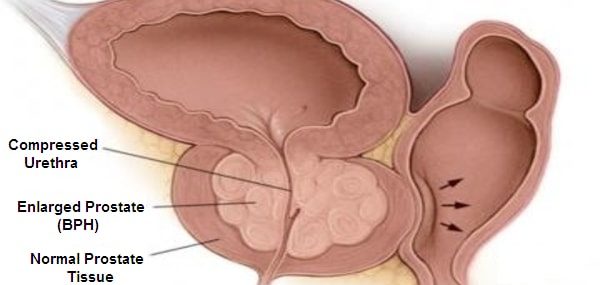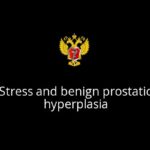Benign Prostatic Hyperplasia (BPH) Causes Symptoms and Treatment
What is benign prostatic hyperplasia?
Benign prostatic hyperplasia (BPH), also known as Benign Prostate Enlargement (BPE), is a progressive disorder that affects almost all men as they get older, it is characterized by an enlarged prostate gland, the gland that surrounds the urethra. When present, prostate gland enlargement can cause uncomfortable urinary symptoms, such as urinary hesitancy (difficulty starting urine stream, weak urine stream and dribbling), nocturnal polyuria, recurrent urine infections, and hematuria. Depending on its size, an enlarged prostate can also cause bladder, urinary tract or kidney problems.
Is an enlarged prostate serious?
In most cases, benign prostatic hypertrophy, or BPH, is usually not dangerous; however, as the prostate grows larger, it may press on the urethra and can also cause bladder, urinary tract or kidney problems, such as recurrent urinary tract infections and hematuria (blood in the urine).
Benign prostatic hyperplasia (BPH) is progressive in many men!!
Benign prostatic hyperplasia is not the same as prostate cancer, although the two conditions may coexist. If left untreated, BPH can increase your risk of developing prostate cancer.
What is the normal size of a prostate gland?
Around the age of 40, a healthy prostate measures about 1.6 x 1 x 1.2 inches (4 x 2 x 3 cm) and weighs about 2/3 to 3/4 of an ounce (20–25 grams).
The normal prostate size for an adult male is 15 cm3 to 30 cm3 (0.91 to 1.83 cubic inches).
What is enlarged prostate size?
Around the age of 43, a normal prostate size is similar to that of a golf ball or walnut.
Men whose prostate gland is larger than 1.83 cubic inches (30 cm3) are more likely to be diagnosed with either benign prostatic hyperplasia (BPH) or prostate cancer.
Symptoms
BPH can be asymptomatic or symptomatic; however, in symptomatic cases of BPH, the severity of symptoms depends on the size of the prostate gland!
What are the signs and symptoms of benign prostate enlargement?
Common signs and symptoms of benign prostate enlargement include:
1- Frequent or urgent need to urinate.
2- Difficulty starting urine stream, weak urine stream, a stream that stops and starts, and dribbling at the end of urination (urinary hesitancy)
3- Inability to completely empty the bladder.
4- Nocturia or excessive urination at night
5- Benign prostatic hyperplasia can also cause rectal problems such as constipation, rectal urgency, anorectal pain (anodynia and proctodynia), and fecal incontinence (trouble controlling bowel movements).

What does it mean when you pee a lot at night?
People with nocturnal polyuria need to wake up frequently during the night to urinate
Normally, most people don’t need to wake up during the night to urinate because the body produces a smaller volume of concentrated urine during sleep time. This means that people can sleep uninterrupted for 6 to 8 hours.
How many times is it normal to urinate at night?
During sleep time, your body produces a smaller volume of concentrated urine. This means that most people can go 6 to 8 hours between peeing and can sleep uninterrupted for 6 to 8 hours. However, getting up once or twice at night to pee is pretty normal, especially if you had a cup of chamomile tea before bed.
What are the warning signs of prostate cancer?
Prostate cancer can be asymptomatic or symptomatic; however, in symptomatic cases of prostate cancer, symptoms can include:
1- Dysuria or a burning sensation while urinating or during ejaculation
2- Urinary Urgency or a frequent urge to urinate
3- Hematuria or blood in urine
4- Hematospermia or blood in semen
5- Osteodynia (pain in the bones or ostealgia)
6- Erectile dysfunction (ED)
7- Urinary hesitancy or difficulty starting or stopping a stream of urine.
8- Inability to urinate standing up
Can an enlarged prostate cause erectile dysfunction?
Erectile dysfunction (ED) and prostate enlargement are separate disorders that increase with age. However, the two problems are somewhat linked. Certain medications that relieve enlarged prostate can cause erectile dysfunction and other sexual dysfunctions such as low desire and decreased libido
Causes
What are the main causes of benign prostatic hyperplasia?
The main causes of prostate enlargement include:
1- Chronic prostatitis (chronic prostate infection)
2- Aging, prostate enlargement occurs to almost all men as they get older, in fact, it is the most common health problem in men older than 60 years of age
When a man reaches his 40s, the prostate usually starts to enlarge
3- Prostate cancer
Other causes of bening prostatic hyperplasia include:
- Chronic hypertestosteronemia
- Sexual addiction or hypersexuality
- Frequent masturbation, masturbating twice everyday may induce prostatitis
- Sexual perversion and porn addiction
- Cigarette smoking
- Alcohol abuse
- Malnutrition and zinc deficiency
- Heavy caffeine consumption (heavy coffee drinking), such as drinking more than 15 cups of coffee a day or drinking more than 10 cans of cola everyday
Diagnosis
How to diagnose benign prostatic hyperplasia (BPH)?
Diagnosis is made based on clinical symptoms and diagnostic test results
Common diagnostic tests include:
- Rectal digital exam
- CT of the abdomen and pelvis with iv contrast
- The prostate-specific antigen (PSA) blood test
- A complete blood count (CBC)
- A urinalysis
- Testosterone blood test
- Electrolyte Panel Blood Test
- Zinc blood test
- A semen analysis
- Male genital examination

Rectal digital exam
Treatment
What drugs are used to shrink the prostate and how to treat BPH symptoms?
You can take alpha-blockers such as terazosin (Hytrin), doxazosin or tamsulosin (Flomax) to help relax the prostate and bladder muscles, making it easier to urinate. You can also take 5α-reductase inhibitors such as dutasteride (Avodart) or finasteride (Proscar) for up to six months to block the action of the type II 5α-reductase intracellular enzymes that convert androgen testosterone into dihydrotestosterone (DHT) in the prostate gland, for reducing BPH symptoms. These medications shrink your prostate by blocking the hormones that cause the prostate to grow. Side effects include retrograde ejaculation
How to shrink the prostate fast?
5α-reductase inhibitors, such as Proscar (up to 80 mg/day PO for three months), work by decreasing the production of dihydrotestosterone (DHT) in the prostate gland, these drugs are often used to shrink the prostate and to prevent or delay the development of prostate cancer in healthy elderly men (>= 55 years of age) with a serum total PSA value of less than 3 ng/mL
What medication is best for enlarged prostate?
Combination therapy is indicated for the treatment of individuals with BPH. 5-alpha-reductase inhibitors in combination with alpha-blockers are often prescribed for men who have moderate to severe BPH. The most commonly used combinations for BPH include: Finasteride and doxazosin, or Dutasteride and tamsulosin.
Combination therapy is often used for postponing or eliminating the need for surgical intervention!!
Combination therapy using α-blockers and antimuscarinics or antimuscarinics and 5α-reductase inhibitors may also be used for BPH urinary symptoms. Antimuscarinic drugs (tolterodine, propiverine, solifenacin, and oxybutynin) in combination with alpha-blockers are also used in the management of men with BPH; however, this combination therapy is not a first-line choice for the treatment of BPH.
Can an enlarged prostate be cured and what kind of surgery is done for enlarged prostate?
In most cases, BPH is treatable but not curable without surgery. Combining different classes of drugs such as alpha blockers and 5α-reductase inhibitors don’t cure an enlarged prostate, but they can help to relieve symptoms, making it easier to urinate. However, a TURP procedure (transurethral resection of the prostate) is the first choice of surgeries for BPH. TURP relieves BPH symptoms quickly
In the United States, about 150,000 men undergo transurethral resection of the prostate (TURP) each year!!
What lifestyle changes can help prevent an enlarged prostate and how can we avoid prostate enlargement without medications?
1- Eat more fruits and vegetables
2- Focus on eating low-fat foods and choose plant protein over animal protein
3- Drink two cups of green tea per day
4- Avoid foods that are harmful to prostate health
5- Achieve and maintain a healthy body weight. Follow a very low-calorie diet (VLCD), and if you are obese or overweight, reduce your daily calorie intake by 500-1200 calories for weight loss
6- Take supplements that support prostate health, like saw palmetto, β-Sitosterol (beta-sitosterol), pygeum africanum bark extract supplement, rye grass pollen extract (Secale cereale), cernitin pollen extract (Cernilton®), and stinging nettle root extract (Urtica dioica)
Take 20 mg of beta-sitosterol three times a day for enlarged prostate (BPH) or prostatitis
Take 320 milligrams of saw palmetto split into two doses daily for at least 6 weeks to have an effect. Saw palmetto supplement may block 5-alpha-reductase.
Take 200 mg of pygeum (the bark of the African plum tree or pygeum africanum) a day for treating symptoms of enlarged prostate
Take 126 mg of Rye grass pollen extract (2 tablets), three times a day for prostate conditions such as benign prostatic hyperplasia and prostatitis
For benign prostatic hyperplasia, prostate pain, or prostatitis, take 63 mg of cernitin pollen extract (Cernilton(®), twice daily, for up to 24 weeks
For prostate problems or BPH, Take 240-300 mg of stinging nettle root dry extract (Urtica dioica) per day in capsules or tablets
1- Follow a balanced diet
2- Eat fruits that are high in vitamin C and antioxidants, like strawberries, blackberries, pomegranates, and raspberries.
3- Eat foods that are high in omega-3 fatty acids, like fatty fish
4- Eat foods that are high in fiber, such as avocados, fava beans, black beans, kidney beans, wheat germ and soybeans
5- Eat foods that are high in zinc, like nuts, shellfish, chickpeas (garbanzo beans), pumpkin seeds, whole grains, and legumes
6- Drink two cups of green tea a day
7- Eat low calorie fruits, like plums, cantaloupes, grapefruits, papayas, peaches, and watermelon (contains only 46 calories per cup)
What foods to avoid when you have an enlarged prostate?
Watch what you eat and drink, avoid foods and drinks that aggravate your BPH symptoms. Common foods and drinks that aggravate BPH symptoms include:
- Eggs and red meat
- Processed foods and sugar
- Caffeinated beverages, such as coffee, tea, cola, and chocolate drinks
- Spicy foods
- High fat dairy foods
- Alcohol
What vitamins are good for your prostate?
Take 100 mcg of selenium and 200 IU of vitamin E with mixed tocopherols daily to ensure natural prostate health and to protect against prostate cancer.
How do you exercise your prostate and how to do kegel exercise at your home?
Firstly, identify the pelvic muscles (Kegel muscles), located behind your balls (testicles). Put your hand behind your balls and urinate to feel the urine stream, and then stop it and feel the muscle contraction, do it for a couple of times to easily find your pelvic muscles.
1- Begin your pelvic floor exercise, also known as Kegel exercises, with an empty bladder.

2- Lie down flat on the floor with your knees bent up, legs bent at 90 degrees angle. See the pictures below.

3- Just contract your pelvic floor muscles for three seconds and then relax them for three seconds, repeatedly try contracting and relaxing your Kegel muscles, the muscles that form part of the pelvic floor, to make the muscles of your pelvic floor stronger. Repeat a few times to increase blood flow and strengthen the pelvic floor muscles.
Daily exercising of pelvic muscles (Kegel muscles) that support the bladder and help to control the urine flow can improve your BPH symptoms
Verified by: Dr.Diab (July 14, 2018)
Citation: Dr.Diab. (July 14, 2018). What is Benign Prostatic Hyperplasia BPH? Causes Symptoms and Treatment. Medcoi Journal of Medicine, 27(2). urn:medcoi:article20619.














There are no comments yet
Or use one of these social networks